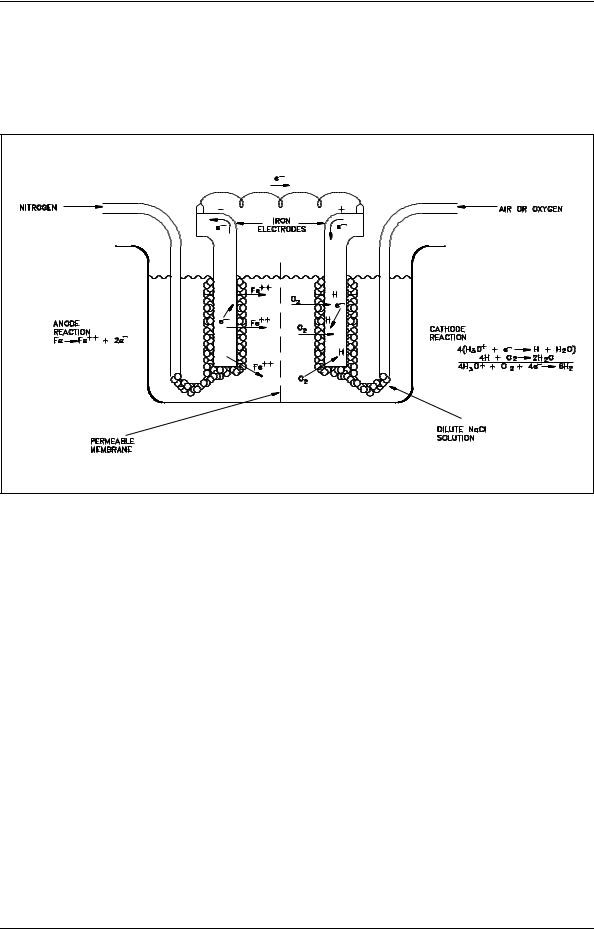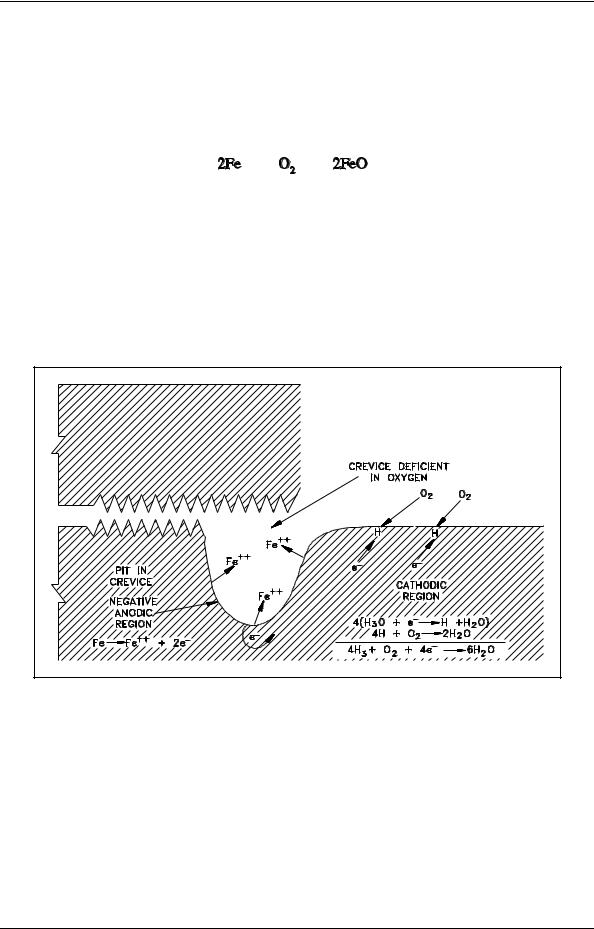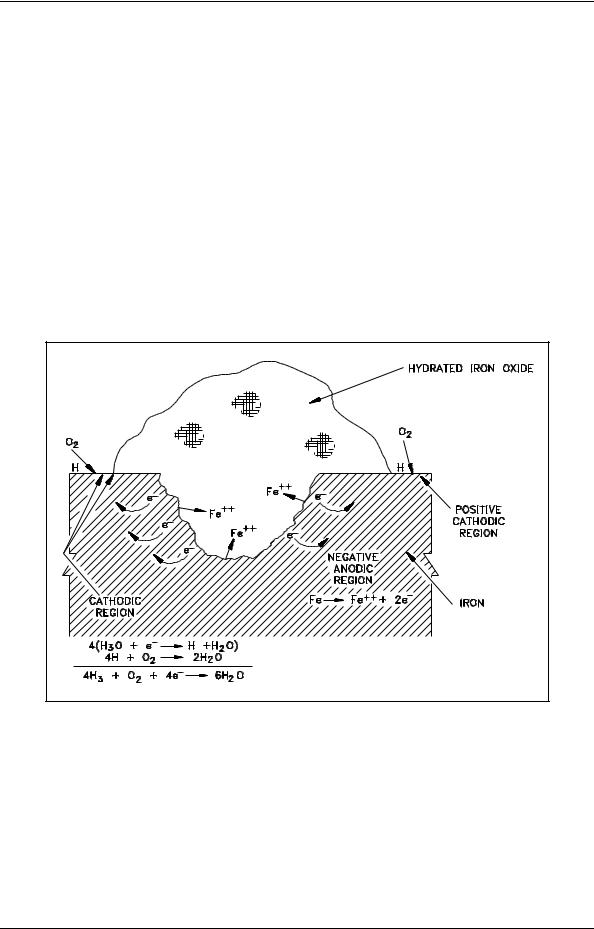
- •ABSTRACT
- •FOREWORD
- •OVERVIEW
- •TABLE OF CONTENTS
- •LIST OF FIGURES
- •LIST OF TABLES
- •REFERENCES
- •OBJECTIVES
- •CHARACTERISTICS OF ATOMS
- •Characteristics of Matter
- •The Atom Structure
- •Chemical Elements
- •Molecules
- •Avogadro's Number
- •The Mole
- •Mole of Molecules
- •Summary
- •THE PERIODIC TABLE
- •Periodic Table
- •Classes of the Periodic Table
- •Group Characteristics
- •Atomic Structure of Electrons
- •Summary
- •CHEMICAL BONDING
- •Chemical Bonding
- •Ionic Bonds
- •Covalent Bonds
- •Metallic Bonds
- •Van der Waals Forces
- •Organic Chemistry
- •Alkanes
- •Alkenes
- •Alkynes
- •Aromatics
- •Alcohols
- •Aldehydes
- •Basic Chemical Laws
- •Forming Chemical Compounds
- •Combining Elements
- •Summary
- •CHEMICAL EQUATIONS
- •Le Chatelier's Principle
- •Density
- •Molarity
- •Normality
- •Parts per Million
- •Chemical Equations
- •Balancing Chemical Equations
- •Summary
- •ACIDS, BASES, SALTS, AND pH
- •Acids
- •Bases
- •Salts
- •Dissociation Constant
- •Summary
- •Introduction
- •Isotopic Separation
- •Separation Factor
- •Stage Separation
- •Barrier Measurements
- •Cascade Theory
- •Circuit Balances
- •CONVERTERS
- •Converters
- •Converter Construction
- •The Gas Cooler
- •Barrier Tubing
- •Process Gas Flow
- •Diffusion
- •TABLE OF CONTENTS
- •LIST OF FIGURES
- •LIST OF TABLES
- •REFERENCES
- •OBJECTIVES
- •CORROSION THEORY
- •Corrosion
- •Electrochemical Cells
- •Oxidation-Reduction Reactions
- •Passivity and Polarization of Metal
- •Summary
- •GENERAL CORROSION
- •Conditions Contributing to General Corrosion
- •Corrosion of Iron
- •Factors Affecting General Corrosion Rate
- •Prevention Chemistry Control
- •Corrosion of Aluminum
- •Summary
- •CRUD AND GALVANIC CORROSION
- •Crud
- •Galvanic Corrosion
- •Prevention of Galvanic Corrosion
- •Summary
- •SPECIALIZED CORROSION
- •Pitting and Crevice Corrosion
- •Stress Corrosion Cracking
- •Summary

Corrosion |
DOE-HDBK-1015/1-93 |
SPECIALIZED CORROSION |
|
|
|
SPECIALIZED CORROSION
The environment in which a metal exists has direct bearing on the corrosion rate of that metal. Because of the unique environment possible in the nuclear industry, there are a few specialized types of corrosion that must be considered.
EO 1.20 DEFINE the following terms:
a.Pitting corrosion
b.Crevice corrosion
c.Stress corrosion cracking
EO 1.21 STATE the two conditions necessary for pitting corrosion to occur.
EO 1.22 STATE the particular hazard associated with pitting corrosion.
EO 1.23 STATE the four controls used to minimize pitting corrosion.
EO 1.24 IDENTIFY the three conditions necessary for stress corrosion cracking to occur.
EO 1.25 DEFINE the term chemisorption.
EO 1.26 STATE the hazard of stress corrosion cracking.
EO 1.27 STATE the three controls used to prevent stress corrosion cracking.
EO 1.28 DESCRIBE the two types of stress corrosion cracking that are of major concern to nuclear facilities including:
a.Conditions for occurrence
b.Method(s) used to minimize the probability of occurrence
Pitting and Crevice Corrosion
Another possible effect of dissolved oxygen is accelerated localized attack. This is especially likely in areas of limited circulation. The resulting corrosion is called pitting corrosion.
Rev. 0 |
Page 27 |
CH-02 |

SPECIALIZED CORROSION |
DOE-HDBK-1015/1-93 |
Corrosion |
|
|
|
Pitting corrosion occurs where the anodic site becomes fixed in a small area and the formation of holes (deep attack) in an otherwise unaffected area takes place. Crevice corrosion is a type of pitting corrosion that occurs specifically within the low flow region of a crevice.
Figure 11 Differential Aeration Cell
To illustrate pitting attack, consider a special type of galvanic cell called a differential aeration cell such as the one illustrated in Figure 11. This particular differential aeration cell is showing current flow as a result of depolarization of one electrode (cathode) by oxygen. In this type of cell, two iron electrodes are exposed to a dilute solution of an electrolyte (NaCl, for example). Air (or oxygen) is bubbled around one electrode, and nitrogen is bubbled around the other. A current flows through the wire connecting the two electrodes. The difference in potential is a result of the difference in oxygen concentration at the two electrode surfaces. At the electrode exposed to nitrogen, electrons are given up by the iron as it is oxidized. These electrons readily flow through the external circuit to the electrode exposed to oxygen. At this depolarized electrode they can participate in a reduction reaction. As a result, oxidation occurs at the electrode exposed to nitrogen and reduction occurs at the aerated electrode. Oxidation at one electrode and reduction at the other creates a potential and a flow of current through the connecting wire. Note that loss of metal occurs at the electrode that is deficient in oxygen.
CH-02 |
Page 28 |
Rev. 0 |

Corrosion |
DOE-HDBK-1015/1-93 |
SPECIALIZED CORROSION |
|
|
|
In iron that is exposed to water, a similar action can occur if adjacent areas of the metal surface become exposed to solutions with different oxygen concentrations. For example, the solution in a crevice exchanges slowly with the bulk of the solution outside the crevice. Oxygen in the solution inside the crevice will be depleted initially by the corrosion reaction.
|
|
(2-12) |
This reaction alone does not produce a protective film on the metal. Because of restricted flow into the crevice, replenishment of oxygen will be very slow; therefore, the solution inside the crevice will have a low oxygen concentration relative to that outside the crevice as shown in Figure 12. The two adjacent areas then establish a concentration cell with electrons flowing from the region of low oxygen concentration to the region of high concentration. Thus, metal goes into solution (oxidation) inside the crevice, and reduction occurs outside the crevice. Metal ions diffuse out of the crevice, more metal dissolves, and the process continues. This results in the formation of a pit inside the crevice.
Figure 12 Representation of Crevice Pitting
Rev. 0 |
Page 29 |
CH-02 |

SPECIALIZED CORROSION |
DOE-HDBK-1015/1-93 |
Corrosion |
|
|
|
The presence of oxygen can also promote pitting at areas on the metal surface that are initially anodic with respect to an adjacent area. For example, suppose that adjacent areas on a metal surface exhibit slightly different oxidation potentials. Oxidation, or loss of metal, proceeds at the region of higher potential. Corrosion in the region of higher potential leads to formation (at least initially) of a porous oxide film. The thickness of the film formed on the adjacent cathodic region will be much less. Oxygen in the bulk of solution can reach the cathodic surface (with the thin film) more readily than it can the nearby anodic surface region (with the thicker oxide film). Depolarization of the cathodic region (thin film) by oxygen tends to maintain this region cathodic, while a deficiency of oxygen under the thicker porous corrosion film assists in maintaining an anodic condition in this region. The overall result is corrosion, or wasting away, of the metal in the anodic region under the thicker film. Thus, a pit in the metal surface is formed under the mound of surface oxide, as illustrated in Figure 13. Pitting of this type is common in both low temperature and high temperature iron-water systems if precautions are not taken to remove the oxygen from the water within the system.
Figure 13 Pit in Metal Surface Promoted by Depolarization
It is also found that certain ions, notably chloride ions, cause pitting of iron and steel. The exact mechanism by which this occurs is not clear, but in some way chloride ions cause defects in the passivating oxide layer on the metal surface. The defects are highly localized and are surrounded by large passive areas that tend to be cathodic. Thus, a small anodic (oxidation) site is surrounded by a large cathodic (reduction) area. The current density will then be very large at the anodic site, and attack on the metal will be rapid. In some test cases, deep pits have been observed within a few hours.
CH-02 |
Page 30 |
Rev. 0 |
